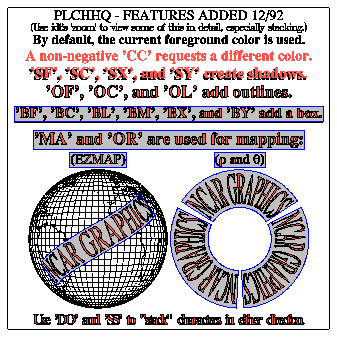
Previous Chapter LLUs Home Next Chapter IndexThere are several methods for drawing text and symbols on a plot and controlling their characteristics, such as their color, angle, font, and position. The following modules demonstrate how to draw text and symbols and set their characteristics using GKS and higher level routines.

----------------------------------------------------------------------
Parameter Brief Description Fortran type
----------------------------------------------------------------------
AS Sets chAracter Spacing Real
BC Box Color Integer array
BF Box outline, Fill, and shadow Integer
BL Box Line width Real
BM Box Margin width Real
BX Box shadow X offset Real
BY Box shadow Y offset Real
CC SpeCial Color indices Integer array
CD Complex or Duplex dataset Integer
CE String CEntering Integer
CH Digitized Cartographic Height Real
CL PrinCipal Line width Real
CS Constant-Spacing flag Real
CV Cartographic Vertical spacing Real
CW Digitized Cartographic Width Real
DB Bottom text extent box Distance Real
DL Left text extent box Distance Real
DO Character Drawing Order Integer
DR Right text extent box Distance Real
DT Top text extent box Distance Real
FB Bezier curve Fidelity parameter Real
FC Function-Code character Character
FN Font Number or name Character or Integer
IH Digitized Indexical Height Real
IS Indexical size Sub- or superscripting Real
offset
IV Indexical Vertical spacing Real
IW Digitized Indexical Width Real
MA MApping flag Integer
OC Outline Color specifier Integer
OF Outline Flag Integer
OL Outline Line width Real
OR Out-of-Range flag Integer
PH Digitized Principal Height Real
PS Principal size Sub- or superscripting Real
offset
PV Principal Vertical spacing Real
PW Digitized Principal Width Real
QU QUality flag Integer
SA Character size multiplier Real
SC Shadow Color Integer
SF Shadow Flag Integer
SL Shadow Line width Real
SS Subtract Space flag Real
SX Shadow X offset Real
SY Shadow Y offset Real
TE Text-Extent computation flag Integer
XB Last string X Beginning -- output Real
XC Last string X Center -- output Real
XE Last string X End -- output Real
YB Last string Y Beginning -- output Real
YC Last string Y Center -- output Real
YE Last string Y End -- output Real
----------------------------------------------------------------------
----------------------------------------------- Parameter Brief description Fortran type ----------------------------------------------- HW Character aspect ratio Real MA MApping flag Integer OR Out-of-Range flag Real -----------------------------------------------
------------------------------------------ Parameter Brief Description Fortran type ------------------------------------------ MA MApping flag Integer OR Out-of-Range flag Real ------------------------------------------
This module explains how to set and retrieve these parameters.
CALL PCGETC (PNAM, CVAL)
CALL PCGETI (PNAM, IVAL)
CALL PCGETR (PNAM, RVAL)
CALL PCSETC (PNAM, CVAL)
CALL PCSETI (PNAM, IVAL)
CALL PCSETR (PNAM, RVAL)
The following function call could be used to retrieve the name of the element of a parameter array:
PCPNWI (PNAM, IPAI)PNAM is the parameter name and IPAI is an integer variable containing the desired index value. Note that any routine that uses PCPNWI must contain the following declaration:
CHARACTER * 16 PCPNWISo, for example if IPAI equals 3, then the value of:
PCPNWI ('CC', IPAI)
is the character string 'CC(3)' (padded with blanks to the right), and the call:
PCSETI (PCPNWI ('CC', IPAI), 62)
sets element 3 of the CC array to 62. In this case, it would be easier to write:
PCSETI (CC(3), 62)but that misses the point that the variable IPAI will not always be known.
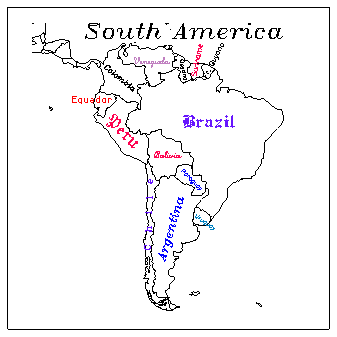
1 CALL DFCLRS 2 CALL GSTXCI (4) 3 CALL GSCHH (3.) 4 CALL GSTXFP (-16, 2) 5 CALL MAPTRA (-10., -60., X, Y) 6 CALL GTX (X, Y, 'Brazil') 7 8 CALL GSTXCI (4) 9 CALL GSCHH (1.5) 10 CALL GSTXFP (-7, 2) 11 CALL MAPTRA (-40., -72., X, Y) 12 CALL GSCHUP (-1., 0.03) 13 CALL GSCHSP (2.) 14 CALL GTX (X, Y, 'Chile')
CALL GTX (XCOORD, YCOORD, STRING)
The fgkgtx.f code segment plots the strings "Brazil" and "Chile" in the graphic. This code segment demonstrates how to set the character color, spacing, height, orientation, and font. These attributes must be set prior to making the GTX call that draws the text.
Line 1 calls a routine that creates a color table for specifying the character color.
Line 2 sets the character color. The argument passed to the GSTXCI routine is an index in the color table created in line 1. All text drawn with GTX will have this color until GSTXCI is called again.
Line 3 sets the character height. The argument to GSCHH is a real value representing the character height in user coordinates. This value is any real number greater than 0.
Line 4 sets the font. The first argument to GSTXFP is the integer value that determines the font. The default is 1, which specifies the ASCII font. This example sets the font to Hershey Gothic English. The second argument sets the type of precision used in subsequent calls to the GTX output primitive. The value 2 (the default) specifies the best possible stroke precision. Valid font numbers are 1 and any integer in the range -2 to -20. The absolute value of these font numbers corresponds to the fontcap databases 1 through 20 listed in a later module.
Line 5 calls the Ezmap routine MAPTRA; this converts the input latitude and longitude values into coordinates that can be used in the GTX routine. The MAPTRA call should be made after the Ezmap routine MAPINT or MAPDRW is called.
Line 6 draws the string "Brazil" using the attributes set above.
Line 8 sets the text color. In this segment the color is the same as the one used for the "Brazil" string, so this call is redundant.
Line 9 sets the character height.
Line 10 selects the Hershey complex Roman font. Please see the module "Fontcap databases 1-20" for a list of all valid GTX fonts.
Line 11 converts the input coordinates from latitude/longitude values to coordinates that can be used by GTX.
Line 12 establishes a vector direction parallel to a vertical line through a character's center. This sets the angle at which text will be drawn. The first argument is the X coordinate of a vector tip, and the second is the Y coordinate. The vector tail is at (0, 0). Thus the arguments 0.0, 1.0 would imply normal character positioning. This example, however, sets the vector at almost a right angle to this, and, therefore, any strings will be drawn in a direction that runs from the bottom to the top of the plot.
Line 13 sets the amount of white space between characters. The argument is a fraction of the character height, so in this example there are two white spaces between every character in the string "Chile."
Line 14 draws the string "Chile" with the attributes set above.
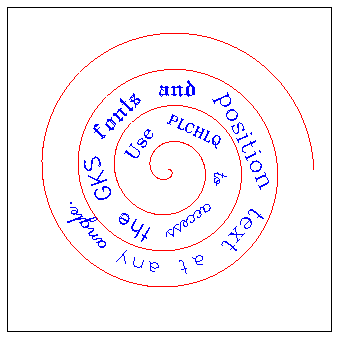
1 CALL GSTXCI (4) 2 CALL GSTXFP (-13, 2) 3 CALL PLCHLQ (.41, .58, 'Use', .04, 55., 0.) 4 CALL PLCHLQ (.58, .62, 'PLCHLQ', .03, -25., 0.) 5 CALL GSTXFP (-6, 2) 6 CALL PLCHLQ (.66, .47, 'to', .04, -90., 0.) 7 CALL PLCHLQ (.57, .33, 'access', .05, -145., 0.)
CALL PLCHLQ (XPOS, YPOS, CHRS, SIZE, ANGD, CNTR)
An idiosyncrasy of using PLCHLQ, PLCHMQ, and PLCHHQ is that PLCHLQ uses calls to the GKS routine GTX to draw text, whereas PLCHMQ and PLCHHQ call the GKS routines GPL and GFA. The implication is that changing text characteristics such as its color requires you to use GSTXCI for PLCHLQ and GSPLCI, and GSFACI for PLCHMQ and PLCHHQ. A better way to change character color when using PLCHHQ is to use the parameters provided for color-setting.
Line 1 of the fpcloqu.f code segment sets the color of text by specifying an index (4) in the color table that was set up previously with the GKS routine GSCR.
Line 2 chooses a font (Hershey triplex Roman) and sets the stroke precision to "best."
Line 3 plots the character string "Use" at coordinates (.41, .58) with characters that correspond to a blank size that is 4 percent of the width of the plotter frame. The string is drawn at a 55-degree angle, and (.41, .58) is the center of the string.
Line 4 plots the character string "PLCHLQ". The arguments specify a new location, size, and angle.
Line 5 changes the font to Hershey simplex script.
Lines 6 and 7 plot the strings "to" and "access".
This module demonstrates how to draw text with PLCHHQ and set text characteristics such as font type, size, superscripting, subscripting, and angle.
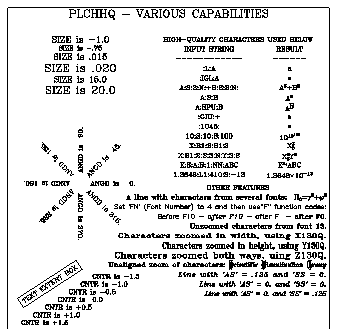
1 CALL PLCHHQ (.225, .453, ' ANGD is 45.', .012, 45., -1.)
2 CALL PLCHHQ (.875, .750, 'A:S:2:N:+B:S:2:N:', .012, 0., 0.)
3 CALL PCSETC ('FC - FUNCTION CODE CHARACTER', '/')
4 CALL PLCHHQ (.990, .410, '/F13/A line with characters from several f
5 +onts: /F8/P/BF13/0/N/=/F5/g/SF13/2/N/+/F5/j/SF13/2/N/',
6 +.012, 0., 1.)
CALL PLCHHQ (XPOS, YPOS, CHRS, SIZE, ANGD, CNTR)
Line 1 of the fpchiqu.f code segment uses the default font (principal Roman) and character database (PWRITX) to draw the text "ANGD is 45.". The text is drawn at a 45-degree angle because of the ANGD argument.
Line 2 uses function codes to draw the equation "A2+B2". The "A" is written with the default font. The ":S:" turns on one level of superscripting. The "2" is written as a superscript. ":N:" returns to the normal level. "+ B" is drawn normally. ":S:" turns on superscripting again. "2" is written as a superscript. Finally, ":N:" returns to the normal level.
Line 3 switches the function code character from a colon to a slash. Line 4 draws a text string that includes several fonts, subscripting, and superscripting.
The "/F13/" in the CHRS argument selects font 13 from the fontcap database. The characters "A line with ... fonts" is drawn in font 13. The "/F8/" selects font 8. The "P" draws the P from font 8, which is the pi symbol. "/BF13/0" turns on subscripting using font 13 and draws the character zero. The "/N/=" returns drawing to the normal level and draws an equal sign. "/F5/g" selects font 5 and draws the gamma character. The "/SF13/2" turns on superscripting, selects font 13 and then draws "2" as a superscript. The "/N/+" returns drawing to a normal level and draws the plus sign. "/F5/j" selects font 5 and draws a "j." The "/SF13/2" turns on superscripting, selects font 13 and draws a superscripted 2. Finally, the "/N/" returns drawing to the normal level.
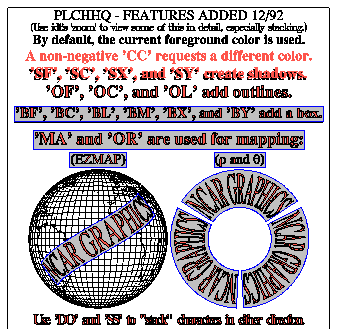
1 CALL PCSETI ('CC - CHARACTER COLOR', 4)
2 CALL PLCHHQ (.5, .850, ':F26:A non-negative ''CC'' requests a differ
3 +ent color.', .026, 0., 0.)
4 CALL PCSETI ('SF - SHADOW FLAG', 1)
5 CALL PCSETR ('SX - SHADOW OFFSET IN X', -.15)
6 CALL PCSETR ('SY - SHADOW OFFSET IN Y', -.15)
7 CALL PCSETI ('SC - SHADOW COLOR', 1)
8 CALL PLCHHQ (.5, .796, ':F26:''SF'', ''SC'', ''SX'', and ''SY'' crea
9 +te shadows.', .028, 0., 0.)
10 CALL PCSETI ('SF - SHADOW FLAG', 0)
11 CALL PCSETI ('OF - OUTLINE FLAG', 1)
12 CALL PCSETI ('OC - OUTLINE COLOR', 1)
13 CALL PCSETI ('OL - OUTLINE LINE WIDTH', 1)
14 CALL PLCHHQ (.5, .738, ':F26:''OF'', ''OC'', and ''OL'' add outlines
15 +.', .030, 0., 0.)
CALL PCSETI ('CC', icol)
Most text characteristics are controlled using the parameter access routines discussed at the beginning of this section. In particular, text color is controlled by using PCSETI along with the parameter name CC and a color table index that specifies a red-green-blue color value.
Line 1 of the fpchiqu.f code segment sets the character color by specifying the color index 4 in the color table created previously with the GKS routine GSCR.
Lines 2 and 3 draw text using font 26.
Line 4 turns the shadow flag on. A nonzero value means that characters will be drawn with shadows.
Lines 5 and 6 set the X and Y shadow offsets, respectively. The offset is stated as a fraction of the principal character height in the direction of ANGD for X and ANGD+90 for Y.
Line 7 sets the shadow color by specifying the color table index 1.
Lines 8 and 9 draw text using font 26 and shadows.
Line 10 turns off shadows.
Line 11 turns on character outlines.
Line 12 sets the outline color by specifying the color table index 1.
Line 13 sets the outline width. The value is specified as a fraction of "normal."
Lines 14 and 15 draw text with font 26 and outlines.
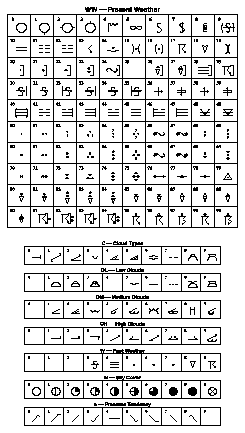
1 DO 30, J=1, NR 2 DO 40, I=1, NC 3 NUM = (NR-J) * NC + I - 1 4 CALL NGWSYM (FONT, NUM, XC(I), YC(J), .43 * YINC, 1, 0) 5 40 CONTINUE 6 30 CONTINUE
CALL NGWSYM (FTYPE, NUM, X, Y, SIZE, ICOLOR, IALT)
The fngwsym example demonstrates how to use the NGWSYM routine to draw a weather symbol chart.
Lines 1 and 2 of the fngwsym.f code segment enter two nested loops for drawing a table of symbols. NR specifies the number of rows, and NC specifies the number of columns in the chart.
Line 3 assigns a symbol number to the NUM variable based on the current indices in the nested loops.
Line 4 draws symbol number NUM from the font specified by FONT. FONT is a character variable that contains one of the weather font character codes described previously under "FTYPE" in the argument section. The XC and YC arrays specify the position of the symbol. The fifth argument specifies a symbol size. The sixth argument, "1", specifies the GKS color index to use to color the symbol. The color table was set up prior to entering this code segment using the GKS routine GSCR. The final argument, "0", specifies not to use the alternate symbol representation.
Lines 5 and 6 terminate the nested loops.
This character set is selected by first setting the parameter CD to 0 (the default) and then selecting the PWRITX database by either using the "F" function codes as described in the PLCHHQ module or setting the parameter FN to 0 (the default).
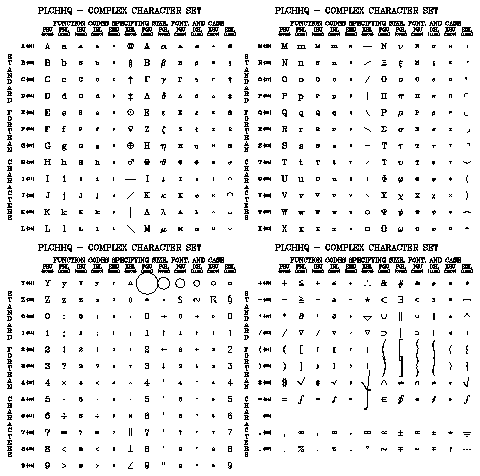
These fontcaps can only accessed by the Plotchar routine PLCHHQ (or PCHIQU).
Previous Chapter LLUs Home Next Chapter Index